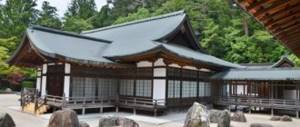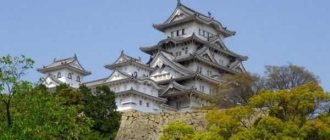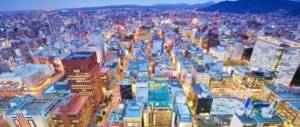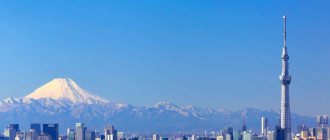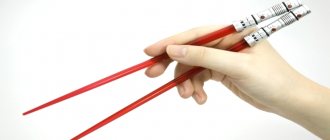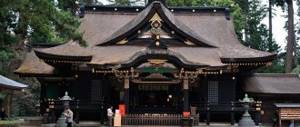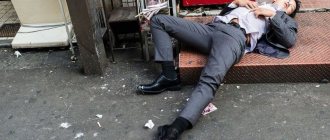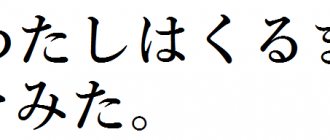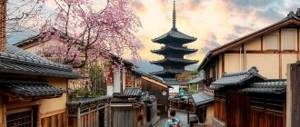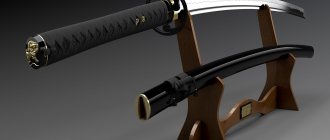Kiyomizu-dera (Japanese name 清水寺, literally "Temple of Pure Water") is one of the oldest and most famous temples in Japan. It is located on the slope of Mount Otowa (音羽山) in the eastern part of Kyoto and its foundation dates back to 778, before Kyoto became the capital of Japan. By the way, the full name of the Temple includes the name of this mountain and sounds like Otowasan Kiyomizu-dera. Since its foundation, the temple has been repeatedly damaged and burned. The current buildings of the temple complex were erected between 1631 and 1633. third shogun of the Tokugawa dynasty, Iemitsu. The temple belongs to the Hosso school of Buddhism. On the territory of the Kiyomizu-dera complex there are about fifteen sacred buildings: temple pavilions, a pagoda, gates...
Nio-mon main gate
The main gate of the temple is Nio-mon (Japanese name: 仁王門 / におうもん). The gate faces the West. Covered with red varnish, in ancient times they were called the Red Gate. The height of the Nio-mon gate is about 14 meters, the width is 10 meters. On both sides of the gate, towering more than three meters high are formidable, intimidating defenders of the Buddha, the Dharma, and, in general, the Buddhist teachings. In Japanese, there are two words for these formidable guardian deities, the guardians who stand at the gates of many Buddhist temples: Nio (仁王) and Kongo Rikishi(金剛力士 / こんごうりきし). One of these formidable deities guarding the entrance to Buddhist temples - Agyo (or otherwise Misshaku Kongo) - holds a vajra in his hands and bares his teeth. The second - Ungyo (or Naraen Kongo) - symbolizes hidden strength, so his mouth is tightly closed. Naraen can hold a sword in his hands. Actually, the name of the gate is Nio-mon
can be literally translated as
“the gate to the temple with statues of the guardians of Nio
.
The gate's gable roof, covered with cypress bark, is designed in the Japanese architectural style "irimoya" (入母屋造り). The peculiarity of this design is that the gable upper tier of the roof goes into the hipped lower one. At the base of the stairs leading to the Nio Gate are stone dogs or even statues that look more like lions (komainu / 狛犬 in Japanese).
Opening hours and prices
Kiyomizu-dera Temple opens at 06:00 am. Its closing time depends on the season, usually at 18:00. During the special night period, the temple closes at 9:30 pm. Last entry is at 21:00. You can find out more about the opening hours of the temple on the official website. The best time to visit the temple is traditionally considered to be the period of flowering trees. The temple park boasts of approximately 1,500 cherry trees and a thousand colorful trees with turning leaves. They bloom in spring and autumn.
The cost of visiting Kiyomizu-dera is 400 yen. The temple organizes a special tour of the complex, led by an English-speaking priest, for foreign guests. Visitors during this event will gain a deeper understanding of Kiyomizu-dera, get acquainted with its historical sites, and hear many interesting stories. Free Wi-Fi is available at the temple entrance or in nearby shops and cafes.
©
Kiyomizu-dera main temple
The main sanctuary of the Temple (Hondo / 本堂), dedicated to the goddess Kannon (観音さま), is distinguished by a vast, prominent terrace supported by more than one hundred wooden pillars approximately 13 meters high. The supports are made of zelkova serrata (Japanese) - a genus of trees from the elm family (Japanese name keyaki - 欅 (ケヤキ)). A distinctive feature of the design is that all these supports are built without a single nail
.
The terrace flooring is made of more than four hundred cypress boards. This type of architectural structure with a protruding part of the building was called kake-zukuri
(懸造 / かけづくり) in Japan. The terrace (or as the Japanese call it the kiyomizu stage - kiyomizu-no butai; 清水寺の舞台) offers stunning views of the city of Kyoto and the surrounding temple complex. Particularly beautiful landscapes can be seen in the spring, when sakura blooms, and in the fall, when the triumph of the bright purple foliage of maples begins. The famous view from the Kiyomizu dera terrace is the hallmark of Kyoto.
Note also that the roof structure of the main temple building, covered with cypress bark, is designated in Japan by the term mukuri-sori
「起り反り(むくりそり)」, since its upper part forms a convex surface, and the lower part forms a concave surface. In this regard, the overall silhouette of the roof looks like a winding arc.
Otowa waterfall, but still
Near the main building of the temple is the so-called Otowa-no-taki waterfall (Japanese name 音羽の滝, which literally means “waterfall of the sound of wings”). The water from the waterfall flows through three gutters (Japanese name 筧 / かけい) into the pond. Visitors to the temple scoop up the flowing water with metal scoops (Japanese name 柄杓 / ひしゃく) and drink it for health, longevity and wisdom. It is believed that everyone can drink from only two sources. It is prohibited to be greedy and drink from three sources. By the way, water from a mountain spring has been flowing here since the founding of the temple. In fact, the presence of a mountain spring gave the name to the temple itself. And the mountain spring itself was found by the founder of the Kiyomizu-dera temple, monk Entin, to whom the goddess of mercy Kannon once appeared in a dream, telling him to settle next to the waterfall.
Jishu Pagoda and Shrine
Behind the central temple of Kiyomizu-dera is the Shinto shrine of Jishu, in which one of the revered deities is the deity of love. In front of the temple there are two stones at a distance of 18 meters from each other. It is believed that if you walk the path from one stone to another on your own with your eyes closed, this will bring you good luck in love and a meeting with your soulmate.
Another building on the territory of the temple complex is the Okunoin Pavilion, which also has its own small terrace. And towards the main temple, Kiyomizu-dera, there is a three-story pagoda and a bell tower. Kiyomizu-dera Pagoda is one of the most beautiful in Japan. Its height is about 31 meters. The southwestern part of the pagoda is decorated with a dragon sculpture on the tiles. The dragon, being the divine protector of Buddha (守護神), is associated with the element of water and is capable of calling down rain. Its presence is a powerful symbol of protection from fires and drought.
Kiyomizu-dera is a pearl of Japanese temple architecture, living history and culture of ancient and medieval Japan.
In 1994, the Kiyomizu-dera temple complex was included in the UNESCO World Heritage List as one of the historical architectural structures of ancient Kyoto and its invaluable cultural heritage.
Thematic dictionary on the topic (for Japanese language learners):
dragon view 眺望 (ちょうぼう) view, perspective 釘 (くぎ) nail; Temple, temple buildings )な vast, huge 檜皮 (ひわだ) cypress bark 筧 (かけgutterのとう) three-story pagoda
LiveInternetLiveInternet
Quote from the message Blog_tourist
Read in full In your quotation book or community!
Kiyomizu-dera Pure Water Temple (Japan)
Kiyomizu-dera, also known as the Pure Water Temple, is one of the most popular Buddhist temples among tourists and pilgrims in Japan. It is located in the city of Kyoto on Mount Otowa. The area is famous for its temples, and Kiyomizu-dera is considered a real gem among them. The temple got its name because of the waterfall that is located nearby. The waterfall is believed to have miraculous powers.
Kiyomizu-dera Temple was founded in 798 by a monk named Entin from the town of Nara. According to legend, he came across a stream and decided to go up its course in the hope of finding its beginning. For several hours, Entin wandered through the forest until he finally emerged into a small clearing shrouded in thick fog. Here the monk discovered an amazing waterfall!
Entin was very tired and decided to spend the night at the source. In a dream, the Thousand-Armed Bodhisattva Kannon appeared to him and ordered the monk to settle not far from the waterfall. Entin not only fulfilled the will of the deity, but also built a small temple nearby in her honor.
Surprisingly, throughout its entire history, the Kiyomizu-dera temple did not belong to any of the sects. For many centuries, absolutely any pilgrim could come here to pray and drink water from the spring.
Over time, Kiyomizu-dera turned into something more than just a temple. Many buildings were built here (prayer hall, main hall, pagoda, bell shed and horse stalls). As a result, Kiyomizu-dera became a real temple complex.
Of course, the main building in the temple was the main hall, where there were altars of several deities at once: the treasure god Bishamonten, the patron god of children and travelers Jizo Botsazu and, of course, the thousand-armed Kanon herself. The altar with the main deity is located in the very center of the main hall, and on the sides are the altars of two other bodhisattvas.
Over its long history, Kiyomizu-dera Temple has experienced many fires and robberies. The most destructive fire for the temple was a fire that occurred in 1200. Then all that was left of the main building was ashes.
Years would pass, and in 1633, part of the temple buildings would be restored by order of Shogun Tokugawa Iemitsu. The newly rebuilt temple was never again subjected to destructive influences, so today we can see Kiyomizu-dera the same as in the 17th century.
You can get to the temple by passing through the Nio Mon gates, on the sides of which there are frightening-looking statues. These are the so-called gate guards or “stone wars”. Behind the gate is a tall three-tiered pagoda, considered one of the tallest in Japan.
Another attraction of the temple is the veranda of the main hall. It hangs right over the cliff, and not a single nail was used in its creation! From here you have a magnificent view of the surrounding Kyoto. This veranda was once used as a dance floor.
Today, Kiyomizu-deru Temple is one of the most popular places among tourists. Thousands of travelers come here every year to admire the magnificent structure and better understand the culture of the Land of the Rising Sun!
Source
Japan Post Series:
Part 1 - Adachi Garden. Japan Part 2 - White Heron Castle (Japan) Part 3 - Kiyomizu-dera Pure Water Temple (Japan)
